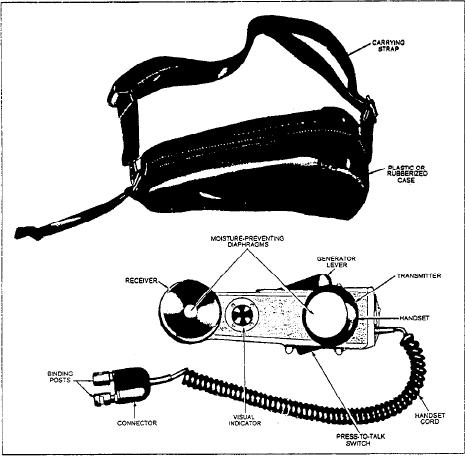
Figure 11-16.--TA-1/PT telephone set.
4. To talk and listen in CBS operation, push in on
3. A transmitter, a receiver with a push-to-talk
the press-to-talk switch when you talk release it when
switch, and a retractable cord.
you listen.
The power supply for the transmitter consists of two
dry-cell (BA-30) batteries in series furnishing 3 volts for
5. To talk and listen in CB operation, you do not
local battery (LB) operation. The batteries are used on
operate the press-to-talk switch.
both local-battery and common-battery signaling (CBS)
6. To adjust the buzzer volume, request a distant
circuits. One battery is installed in the battery
party to signal; then place the handset in the brackets.
compartment with the positive end up; the other with the
When a signal is received, rotate the buzzer control for
positive end down. After you install the batteries, close
desired volume.
the battery compartment cover and fasten the cover
7. To complete the call, place the handset in the
latch. An external, 3-volt battery source maybe used in
retaining brackets. When the set is connected through
place of the two BA-30s. Connect the back from the
an LB switchboard, ring off by turning the hand crank.
external batteries to the BAT binding posts on the panel.
No batteries are required for common-battery operation.
TA-1/PT TELEPHONE
In order to operate the TA-312 with the handset,
follow the instructions listed below.
The TA-1/PT telephone set is a lightweight,
1. Put the EXT-INT SWITCH in the INT position.
waterproof, sound-powered, field telephone for use on
2. To place a call in LB operation, leave the handset
field-wire lines to communicate with other field
in the retaining brackets and turn the generator hand
telephones or local, battery-operated switchboards. The
crank. Remove the handset from the brackets and listen
TA-1/PT is equipped with a visual, incoming-signal
for the party you are calling to answer.
indicator and a generator ringer. It has a talking range of
3 to 6 miles, which is ideal for use on a listening post.
3. To place a call in CB operation, remove the
The set weighs about 2.7 pounds. The basic parts of the
handset from the retaining brackets and listen for the
set are shown in figure 11-16.
operator to answer.
11-19

